If you’ve ever read the comments here on my blog, you are familiar with Kristin, from Going Country. I knew that Kristin is a seasoned veteran in infrequent grocery shopping, so I asked her if she’d be willing to share her tips for the rest of us.
And she graciously said yes. Thank you, Kristin!
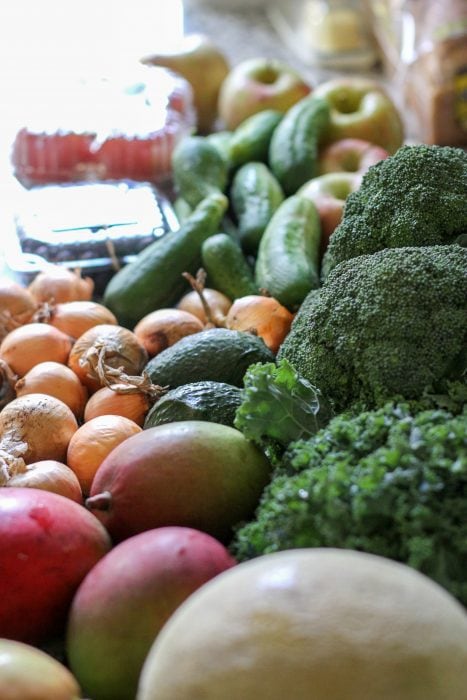
For most of my adult life, I have lived at least 25 miles from what the majority of Americans would consider a “normal” grocery store.
And for the past two years, I’ve lived with my family of six 90 miles from the nearest standard grocery store.
Needless to say, I do not go grocery shopping very frequently.
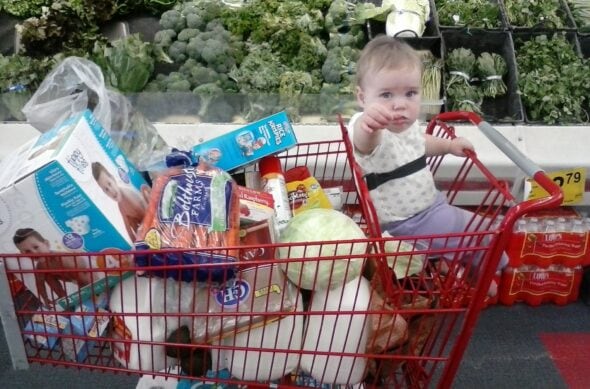
The baby totally helps to make the once-a-month shopping easier (except not actually).
(Please note: photo was from the past, when it was ok to bring babies to the store!)
In fact, my average span of time between trips to a grocery store is four weeks.
Now that people are trying to shop much less frequently in order to stay out of grocery stores, my own experience of shopping so infrequently has become a bit less strange.
Okay, so maybe you’re not trying to go a full month between grocery shopping trips. That’s a little excessive.
But maybe you want to go every week instead of your usual every few days. Or maybe every two weeks instead of every week. It’s doable. It just requires a little adjustment in your planning and execution.
So, without further ado, here are my ten tips for less-frequent grocery shopping.
First, before you go to the store:
1) Sort through your kitchen and think.
I find it helpful to physically open the doors of my food cabinets and refrigerator and stare in them while I think about what I need to buy.
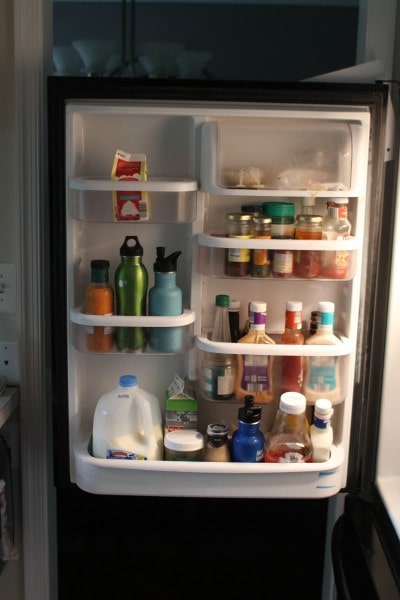
What do you use a lot of? How much of it do you use in a week?
A week is a manageable amount of time to consider your food use, and then you can just multiply that based on how long you want to stay out of a store.
We, for instance, go through about three pounds of cheese a week (my dad is from Wisconsin, which means that my four children are genetically part Cheesehead and they eat accordingly).
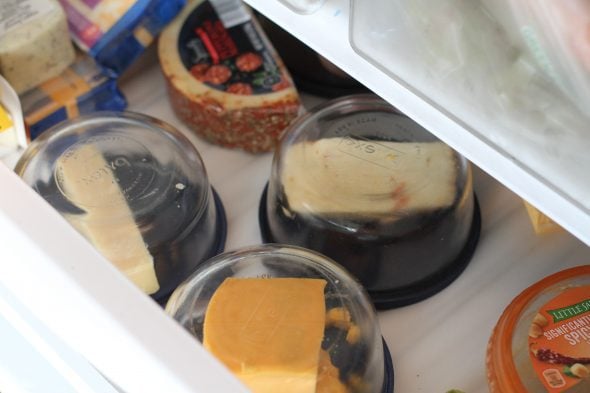
Can you ever have too much cheese? No.
Therefore, when I go to the store, I buy at least twelve pounds of cheese. If you’re not used to shopping for larger quantities, figure out beforehand how much you need to buy and put that number next to the item on your list.
I should note that detailed menu planning is not the best fit for this sort of shopping. It works much better to buy the ingredients and then figure out what to make with them.
You should have a general idea, but must be willing to deviate from the details.
2) Next, make a list.
No, seriously.
You must have a list.
Perhaps you’re an impulsive, fly-by-the-seat-of-your-pants sort of person who finds the idea of a grocery list restricting.
I understand this, but those flying pants are going to be looking pretty dirty if you forget to buy that laundry detergent you ran out of.
This is particularly true for things like laundry detergent that you may not buy regularly. Those are the things you will forget.
Keep a running list–either old-school with a piece of paper on your refrigerator or new-school on your phone–of things you run out of as you run out of them. To that running list, you will add the things from the previous step that you figured you use frequently.
For my fellow throwbacks who prefer to use a paper list, remember to bring the list with you to the store. I’m sure this isn’t a problem for those of you accustomed to keeping lists on your phone, but if you have a paper list, make sure it gets to the store with you.
(Not that I have ever driven almost a hundred miles to go to the grocery store and forgotten my list at home. Ahem.)
When you get to the store:
3) Shop from your list, except when you don’t.
Your list is important as a reminder of what you want to have, but you don’t have to be–and shouldn’t be–blindly devoted to it.
If, for instance, you have “six packages of chicken” on your list, but the store is out of chicken (I understand these things happen in this brave new world we’re living in) or pork is on sale, consider if you can manage with the pork instead.
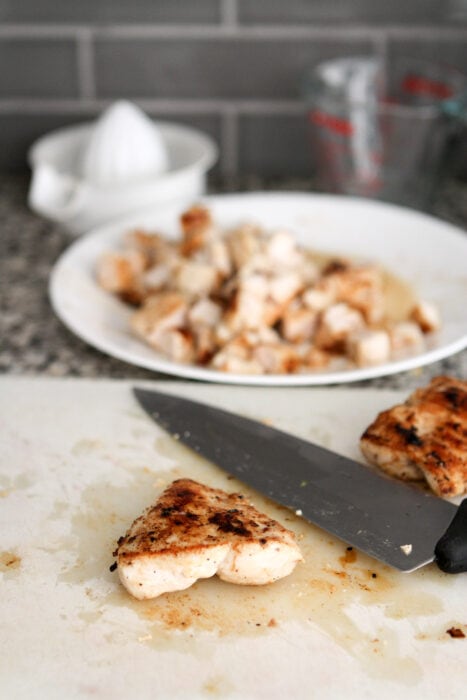
Or fish. Or whatever. Substitute like for like as far as is practical and necessary.
Just be sure to keep the quantities the same.
4) Buy with longevity in mind.
If you love salad and always buy loose leaf lettuce, by all means, get that. But then consider that romaine lettuce lasts about twice as long as loose leaf lettuce.
So get one of each kind to extend your salad days (heh).
And then get cabbage, because it will last for over a month in the refrigerator.
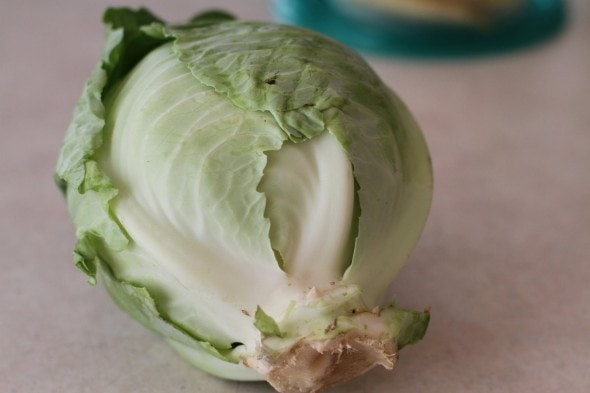
I always buy mushrooms to use within a week or so, but I also always buy carrots and cabbage in quantity, because they will still be hanging on when everything else fresh is long gone.
And then, buy frozen or canned produce. When the last carrot has been consumed by my locust-children, there will still be frozen green beans to fall back on. And speaking of frozen green beans . . .
5) Make friends with your freezer.
I absolutely couldn’t go a month between grocery runs without our big chest freezer. But even if you only have a small freezer, put it to good use.
This is where the extra perishables are going to live, as far as is possible and practical.
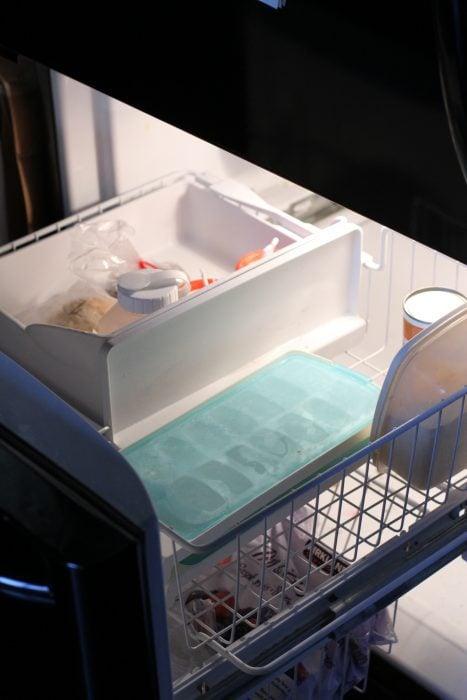
Meat, butter, milk, grated cheese, nuts . . . all these things will keep in the freezer for months.
Frozen fruits and vegetables aren’t as good as fresh, but they’ll be there in the freezer when the fresh is gone. I shop my freezer far more often than I shop at a store.
6) Plan on spending more than you are used to.
You don’t need to go crazy and buy without regard to price, but do expect to be spending a lot more than you would normally.
You are not going to be buying twice the amount of food for less than twice the cost. It will probably make your heart skip a beat when you see the total at the register.
But it’s almost a guarantee that spending more, but more infrequently, will save you money in fewer unnecessary purchases over the long run.
When you get home:
7) Find a place for everything as soon as you get home.
Obviously, perishables will go in the refrigerator or freezer.
If you have purchased, say, meat in larger packages than you usually do, make sure to break it up into smaller, more usable packages before you put it in your freezer. (I use gallon zipper bags most frequently.)
You may have to be creative when it comes to storage of non-perishables. I have a miserably small glorified cupboard that claims to be a “pantry,” and therefore store extra non-perishables in my children’s bathroom cupboard, in some of my pots and pans cabinets, and even on the floor behind my woodstove.
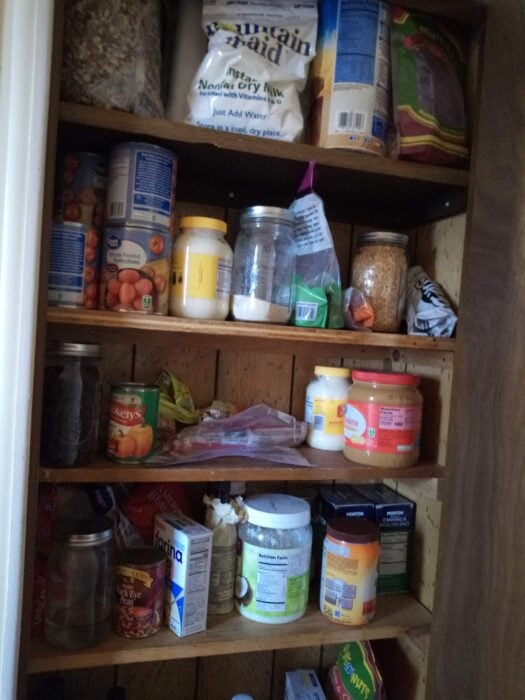
Kristin’s not-so-spacious pantry
Just make sure to group like with like and remember where you’ve stored things. Write it down if you need to.
Or else you may find you’ve somehow misplaced the gallon jug of white vinegar you were sure you bought three weeks ago. (Speaking from personal experience there.)
8) Use your food wisely.
Yogurt before cheese.
Lettuce before kale.
Bananas before apples.
Ripe avocados before everything.
Keep an eye on your perishables and use them in the order in which they will last, from most-perishable to least. This means that you will be flush with all sorts of foods in the beginning and will be down to the immortal cabbage and hard cheeses at the end.
This is the natural cycle of infrequent grocery shopping and means that you will be REALLY EXCITED to have avocados and bananas again when you do go to the store next.
9) Be flexible.
This may be difficult if you’re a real planner, but if your lettuce is on the verge of collapse, you need to have salad that day, not the stir-fry on your menu plan.
You must also be willing to use substitutes for things. If you’re out of sour cream, try yogurt. If you run out of chocolate chips for cookies, make oatmeal-raisin cookies instead.

Put the ingredient in your search engine with “substitutions for” and let the Internet be your guide.
And if there’s no substitution? Resign yourself to making something else.
It’s not the end of the world, even if it feels like it when those brownies you were counting on are a no-go without the crucial chocolate chips that someone seems to have eaten.
10) Accept that you will forget something and also that you can live without it.
Yes, it will be a sad week without the cream for your coffee (a true sad story from my own life), but the milk will be a workable if unsatisfactory substitute in the meantime.
And you will most definitely not forget it the next time you go to the store.

a true tragedy
One last note: it’s going to feel stressful the first time you do a big shopping trip. It takes more time, more mental effort, more physical effort (an overly full grocery cart is excellent resistance equipment for a workout), and more money.
But it will get easier with practice. You may even find that this method of shopping works better for you and your lifestyle.
Even if it doesn’t? This too shall pass.
In the meantime, definitely buy some cabbage.
___________________
Kristin, thank you, thank you for all this helpful info! You are the best.
Readers, if you have even more tips for infrequent grocery shopping, would you add them in the comments?
P.S. You can visit Kristin’s blog, Going Country, by clicking right here.

Lisa
Monday 4th of November 2024
It’s so funny! I shopped this way for years and found this article by Googling “how to downsize grocery shopping.” After reading your article, I don’t think I need to. I just got in the habit of making a trip to the store when I run out of salad instead of making do with something else. Thank you for the tips!
Mary Born
Monday 18th of January 2021
Thanks so much for your helpful tips! I'm trying to get long lasting grocery recipes as I start a Covid cooking club with friends.
Coral Clarke
Wednesday 13th of January 2021
Every morning I check the fridge to see what needs to be used up, and I use it!
Mary
Thursday 30th of April 2020
These are great tips! Tomorrow will make it 4 weeks for me. I, however, am a pretty careful meal planner. I started using plan to eat six months ago and it is a huge help. It isn't free ($30/year maybe?) but it is amazing. I don't need someone else's recipes like most meal planning services, but my old system involved my google calendar, pinterest/cookbooks/whatever for recipes, and an app for the grocery list. I'd plan the recipes, go in the kitchen and check what I didn't have to add to my list and then do the usual things (milk, eggs, etc) based on what we had.
Once I put my recipes in Plan To Eat (yep, took forever, worst part), I can schedule them into my menu....and then it autopopulates my grocery list. The list remembers where I like to buy things, so if it says milk it knows to put that on my Costco list but cauliflower is from Aldi. Then I just go to my staples list and add anything from there that I still need. The major change is now I take things off my list (when I already had that ingredient) instead of putting them on. I had to buy some ultra pasteurized milk (and my kids have recently stopped drinking so much of it) and send 3 extra gallons to my moms, but we're on our last gallon and I'm pretty sure that moving into the frozen and canned produce I have, me and my last 2 eggs can limp along almost another week.
You've all convinced me to get some powdered milk and give it a try for recipes though--I only drink milk & water and I'm not about to drink it (I'd rather just drink water I think) but I can give it a try for mac & cheese. Does it separate like real milk?
flask
Monday 27th of April 2020
i totally came here from kristin's blog to read this.
do you guys have a kristin club?